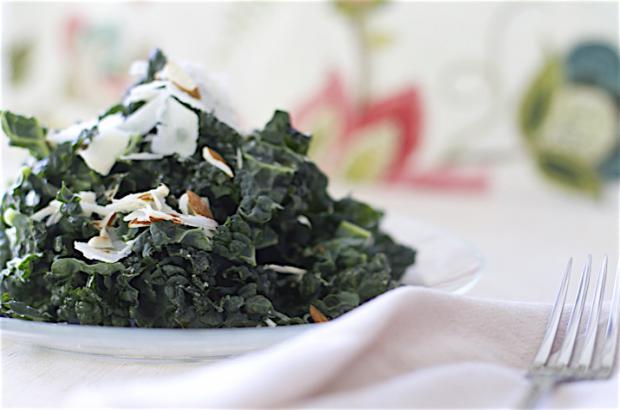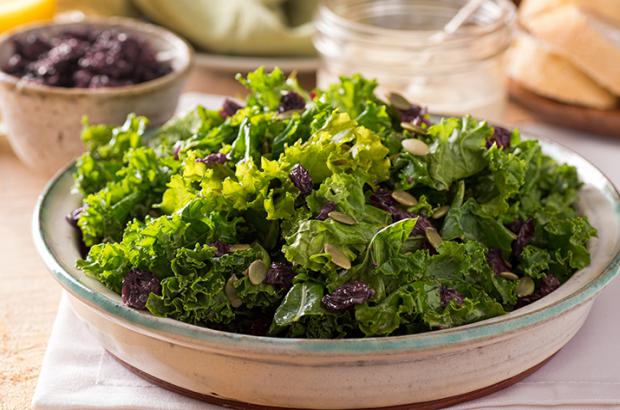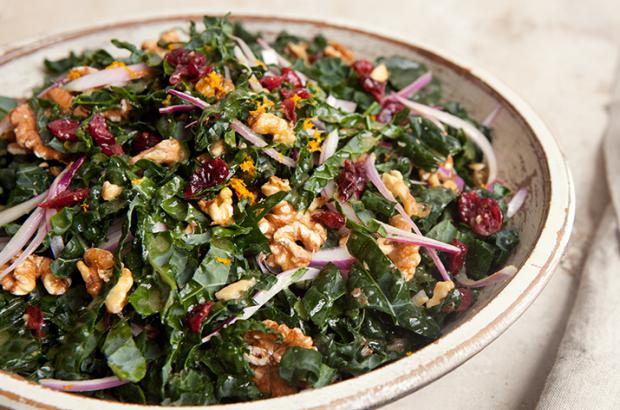Article
Kale

While kale's popularity may seem recent, the hearty leaf was a staple in ancient Greece and Rome and one of the most common green vegetables in Europe up until the end of the Middle Ages. A descendent of wild cabbage, the word kale hails from Scotland—where the phrase "come to kale" was a dinner invitation. Celtic travelers brought the vegetable to Europe around 600 BC, and English settlers brought kale to America in the 17th century.
Kale is a cold-hardy crop, thriving in climates with cooler nights and warm days. A cold snap, especially with a light frost, sweetens the vegetable. In the U.S., California and Wisconsin are major kale producers.
Kale is an excellent source of vitamins A and C and a good source of calcium and potassium. Like other veggies, it's also low in fat, saturated fat free, cholesterol free and low in sodium.
Kale, also called borecole, shares the botanical name Brassica oleracea with a long list of other veggies, like collard greens, broccoli, cauliflower and Brussels sprouts.
Here are some popular varieties of kale:
- Curly leaved or Scots kale is the most common variety. It has a fibrous stalk and ranges from light green to dark purple. Its ruffled leaves are pungent, peppery and sometimes a bit bitter.
- Red Russian kale leaves are flat, fringed, and shaped like oak leaves. More tender than curly varieties and perfect for salads, the leaves are soft green with a red tinge, and the woody stems are reddish-purple. This variety is sweet, mild and slightly peppery.
- Dinosaur kale (also called cavolo nero, black cabbage, black palm, Tuscan cabbage, Tuscan kale and Lacinato) has tall, narrow, dark blue-green leaves and a bumpy, bubbly texture. It's milder, almost nutty/sweet and more tender than other varieties.
- Ornamental or flowering kale is available in green, white, pink or purple—sometimes all on the same plant. While these are edible, they're not as tasty as other varieties and are usually planted for their attractive colors and textures.
The slightly sweet, slightly bitter cabbage taste of kale is delicious raw, sauteed, simmered or roasted. Take care not to overcook it, though, or it may become increasingly bitter.
Toss kale in any stir-fry, steam and serve with a vinaigrette, or saute in sesame oil with garlic and tamari for an Asian touch.
If serving the leaves raw—in a salad, for example—massaging them a bit with dressing will tenderize them. Raw kale stars in Kale Salad with Ginger Miso Dressing and Sesame Kale with Nori. And steamed kale, along with baked tofu and quinoa, makes a hearty Quinoa Kale Salad with Corn. In salads or other recipes, feel free to substitute kale for collard greens.
Other robust vegetables—like onions, potatoes and garlic— are delicious with kale, as in this main-dish Potato Kale Tart, layered with Gruyère cheese and seasoned with nutmeg. Other veggies that work well with kale include tomatoes, sweet potatoes, carrots and beets. A seemingly unlikely combo of kale, baby beets, ricotta and walnuts makes for a stunning and tasty Kale and Beet Pita Pizza.
Add chopped kale to a savory white bean and tomato soup with rosemary for a pop of emerald color and textural interest. For a hearty fall or winter soup, cook kale with potatoes, onion and garlic, as in this Creamy Kale and Pea Soup.
To make kale chips, tear the leaves into bite-sized pieces, toss with olive oil and salt and/or other seasonings, and bake in a 300°F oven until crispy. For seasoning inspiration, check out this recipe for Crispy Kale Chips with Seasonings.
Kale is a good side for poultry, beef, pork, cured meats, sausages, tofu, tempeh, beans, lentils and eggs. Use it to add color, flavor and nutrients to rice and other grain, pasta and corn dishes.
Lemons, limes and oranges enhance kale's flavor. Good nut accompaniments include walnuts, almonds, pine nuts, pecans, peanuts and cashews. Cranberries and dried fruits often add interesting color contrast and coax out the sweet side of kale. For cheeses that flatter robust kale, try feta, Gruyère, Parmesan, goat, blue, Romano, Pecorino and Asiago. Spices like cayenne, cumin, black pepper, ginger, basil, oregano, parsley and curry powder are strong enough to compliment kale. For condiments, olive oil, sesame oil, tamari, balsamic vinegar and mustard are good bets.
While it's available year-round in some temperate climates, the peak season for kale in most areas spans June through November.
Choose kale with firm, deeply colored leaves, free of holes and browning or yellowing. Keep in mind that smaller leaves will usually be more tender and milder than large leaves.
Store kale in a plastic or produce bag, with the air removed, for three to five days in the coldest part of the refrigerator. The sooner you eat the kale, the milder the flavor will be.
Wash the leaves just before using, and remove the tough center stalk before cooking (some cooks like to cut up the fibrous stalk to use in soups, much like celery).
With its distinctive, delicious taste, valuable nutrients and versatility in the kitchen, kale is a veggie worth keeping as a staple in your refrigerator. Move over lettuce!













